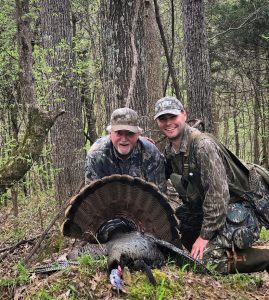By Mark Beason
There’s an awful lot of work that goes into killing a turkey. Scouting, set up, calling, a little big of luck, and making a good shot. No matter if you’ve just killed your first gobbler or if it’s a double-bearded monster, a trophy is in the eyes of the beholder.
Once you have gotten the bird on the ground, you need to make sure to take the proper steps to ensure the mount will come out perfect. While what experienced taxidermist can do often seems like magic, how they get the turkey is critical.
One key thing is keeping the bird dry. Don’t try to wash dirt or mud of the bird, let your taxidermist do that part for you. They have a specific way to clean the bird to ensure the feathers keep their integrity and will come out looking right.
 Dan Heasley is an award-winning taxidermist and has worked on his fair share of gobblers. He said taking care of the head is one of the most important steps. He suggests using a plastic sleeve used to keep newspapers dry or a plastic bag to carefully wrap the head. Once the head is wrapped and sealed, tuck the it under the bird’s wing and then wrap the whole bird in a garbage bag before freezing. He said do not gut the turkey and keep it wrapped tight if putting in a cooler with ice.
Dan Heasley is an award-winning taxidermist and has worked on his fair share of gobblers. He said taking care of the head is one of the most important steps. He suggests using a plastic sleeve used to keep newspapers dry or a plastic bag to carefully wrap the head. Once the head is wrapped and sealed, tuck the it under the bird’s wing and then wrap the whole bird in a garbage bag before freezing. He said do not gut the turkey and keep it wrapped tight if putting in a cooler with ice.
“Keeping it dry really helps it come out better in the long run,” Heasley said. “Properly sealing up the head in a plastic bag helps keep it protected and that’s the most important part.”
Heasley tries to use the birds’ head whenever possible as it’s sent off to be freeze dried. As chokes and turkey loads have improved, it has made saving the head a lot more difficult. A close-range shot from a modern turkey choke can mean more than just a jelly head.
“There are times when we just can’t do anything with it, and we have to use a what we call a stock head,” he said. “They look fine, but I always try my best to preserve them.”
While all gobblers aren’t created equal, neither are all taxidermists. Before entrusting your prize bird to someone, go look at their work. Some taxidermists specialize in certain species, and you want one that has experience with birds. A good taxidermist is an artist and when possible take time to study their previous work.
Tommy Dillard has traveled all over the Southeast and Midwest chasing big Toms. He’s got a several of his favorites mounted, and each tell a unique story. He said he wants the mount to represent the character of the bird and the story behind the hunt.
“It’s the little details that make them look right and having the pose fit the birds helps tell the story,” Dillard said. “I suggest people spend plenty of time looking at different styles and poses. Really talk to your taxidermist about what you want, because when they are done with it you have it forever.”



